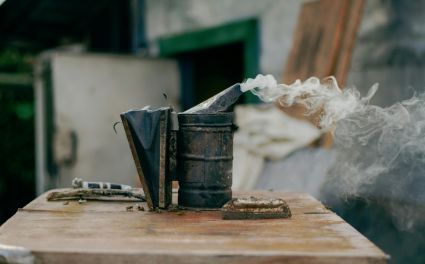Beekeeping requires protective gear to shield beekeepers from potential bee stings and other hazards. The importance of such gear cannot be overstated. The beekeeper suit is at the forefront of beekeeper protection, a specialized garment designed to safeguard beekeepers during hive inspections and honey collection.
These suits are a barrier, preventing direct contact between the beekeeper's skin and the bees. They provide beekeepers with a sense of security and allow them to work with the bees more confidently and comfortably. Understanding the purpose and significance of beekeeper suits is vital for safe and successful beekeeping endeavors.
Outer Layer
A beekeeper suit's outer layer is important because it keeps beekeepers safe and comfortable. Some traditional choices for the outer layer are cotton and polyester. Cotton is a great choice for hot weather because it's breathable and lightweight, which keeps you comfortable. However, it might not be as strong or able to withstand bee stings. Polyester, however, is known for its durability and ability to provide better protection against bee stings. However, it may not be as breathable as other materials.
To consider these factors, many beekeeper suits are made with a combination of cotton and polyester materials. These blends bring together the benefits of both materials. The cotton in this product makes it more breathable and comfortable, while the polyester makes it more durable and resistant to bee stings.
The outcome is a layer on the outside that provides better comfort and durability, balancing protection, and how comfortable it feels for the person wearing it. Beekeepers can work comfortably and safely in their suits for long periods. They have a reliable outer layer that protects them from bee stings while being comfortable and durable.
Inner Layer
The inner layer of a beekeeper suit often incorporates mesh fabric, which serves multiple functions. Firstly, the mesh fabric acts as a barrier, preventing direct contact between the beekeeper's skin and bees while allowing for effective hive observation. Secondly, it facilitates breathability and ventilation, ensuring airflow keeps the beekeeper cool during work.
Regarding material considerations, synthetic mesh materials are commonly used in beekeeper suits. These materials offer several properties that enhance protection. For instance, they are designed to be tightly woven, minimizing the chances of bees penetrating the suit. The synthetic mesh is typically made from materials like nylon or polyester, which provide excellent durability and resistance to bee stings. Additionally, the materials are often treated with anti-static coatings to prevent the accumulation of static electricity that may disturb bees.
Synthetic mesh materials in the inner layer of beekeeper suits strike a balance between protection and breathability, allowing beekeepers to work comfortably and confidently while maintaining adequate safety.
Additional Components
The additional components of a beekeeper suit include the veil and gloves, which offer crucial protection and functionality. The veil, typically attached to the suit's hood, is constructed using fine mesh or netting materials. These materials provide both clear visibility and protection from bee stings. The mesh allows beekeepers to see clearly while preventing bees from accessing their face and neck areas.
Gloves are another essential component, and various materials are available to suit different needs. Beekeeper gloves are typically made from leather, canvas, or synthetic materials. Leather gloves offer excellent protection against bee stings, while canvas gloves balance protection and flexibility. Synthetic materials like nitrile or latex offer additional agility but may be less durable.
The choice of gloves depends on the beekeeper's preferences and specific tasks. It's crucial to balance agility and protection, ensuring that the gloves allow for proper handling of hive components while effectively guarding against bee stings. Combining a well-constructed veil and suitable gloves adds another layer of safety to beekeepers' protective gear.
Suit Construction Techniques
When making beekeeper suits, a lot of care is taken to ensure that the seams and stitching are done using proper techniques. We use reinforcement techniques like double stitching and reinforced seams to make the suit stronger and last longer. By employing these techniques, the seams are made stronger and less likely to tear, ultimately offering extra protection for the beekeeper. In addition, the suit is designed to prevent bees from getting in by having tight and secure stitching all over.
In addition, it's really important to carefully consider the zippers, closures, and fasteners when choosing a beekeeper suit. These elements play a key role in ensuring that the suit functions properly. We use secure closures like strong zippers or Velcro fasteners to ensure bees can't get in. They're designed to cover everything and leave no gaps. These closures are made to be durable and able to handle regular use. They also provide a tight and secure fit. At the same time, we ensure it's easy for beekeepers to put on and take off the suit. This helps them save time and effort when they're working with bees.
Maintenance and Care
To make sure your beekeeper suit lasts as long as possible, it's really important to take good care of it and keep up with regular maintenance. It's really important to clean and wash the suit after each use to eliminate any bee venom, propolis, or debris. It's a good idea to follow the manufacturer's instructions for cleaning. They might suggest hand or machine washing with mild detergent and gentle cycles. It's crucial to avoid harsh chemicals or bleach as they can potentially harm the suit's fabric.
When storing a suit, hanging it in a cool and dry location is a good idea to prevent mold or mildew from developing. It's best to keep it in a special bag or cover made specifically for beekeeping suits. This will help protect it from dust and pests. Ensure you don't leave the suit in direct sunlight for too long, as it can cause the fabric to fade or deteriorate.
It is recommended to regularly inspect the suit for any signs of wear, such as frayed seams or tears. To keep your suit in good shape and stay protected while beekeeping, it's important to repair or replace any damaged parts promptly. This will help maintain the suit's integrity and ensure ongoing protection.
How Does OZ Armour Have the Best Beekeeping Suits?
At OZ Armour, we offer the best beekeeping suits available. Our team is dedicated to ensuring beekeepers access high-quality, reliable, and innovative suits that meet their specific needs.
We understand the importance of providing beekeepers with a range of options to choose from. That's why we offer suits like the 3-Layer Mesh Ventilated Full Bee Suit with Fencing Veil + Free Extra Round Brim Hat, which provides exceptional ventilation and complete body coverage. Our Double Layer Mesh Ventilated Beekeeping Suit with Fencing Veil offers enhanced breathability and protection.
With our Poly Cotton Semi Ventilated Beekeeping Suit with Fencing Veil, we combine the comfort of poly cotton fabric with effective ventilation. We prioritize durability by incorporating reinforced patches, adjustable fittings, and secure closures into our suit designs.
Protecting beekeepers from stings is our utmost concern. That's why we use double-layered or reinforced mesh in strategic areas and ensure that our veils are securely attached. We believe in providing complete coverage of vulnerable areas, including the face, neck, and ankles.
When you choose an OZ Armour beekeeping suit, you can trust that it has been carefully crafted to meet your needs. We are committed to delivering functional, comfortable, and durable suits that enhance your beekeeping experience. Your satisfaction and safety are at the core of everything we do.



